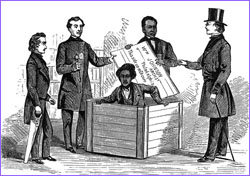 |
 |
Great Escapes
by Lexi Krock
The myriad escape attempts at Colditz Castle (see Escaping Colditz) had a
long pedigree. Throughout history, prisoners of all sorts have gone to
unheard-of lengths to free themselves from confinement, whether it be house
arrest in Tibet or a life sentence in Alcatraz. Most have failed, but a
significant minority has tasted freedom through patience, skill, and, in many
cases, sheer dumb luck. Here, relive some of the greatest jailbreaks of all
time.
| 
A 16th-century portrait of
Mary, Queen of Scots
|
Mary, Queen of Scots (Scotland)
When
Mary, Queen of Scots arrived in Scotland in 1561 from France, where she had
been raised in exile, she expected eventually to assume the throne that was her
birthright. But in 1567, during a rebellion of Scottish nobles, she was
imprisoned in remote Lochleven Castle. Though Mary begged in letters to Queen
Elizabeth and the Queen of France for help in getting free, she was unable to
interest anyone in her cause. Before long, she began plotting her escape.
In her first attempt in March 1568, Mary disguised herself as a laundress and
tried to escape from the castle by boat. But when the boatmen she attempted to
hire noticed her pristine hands and beautiful face, her identity was revealed
and her plan foiled (though remarkably, she did manage to return to her cell
without the castle's guards learning of her ploy). Determined to succeed, Mary
fled the prison again on May 2, 1568. With the help of an orphan she befriended
at the castle, she was able to get out of the castle, across by boat to the
mainland, and successfully away on a horse stolen from her captors'
stables.
Tower of London (England)
The Tower of London has served as a royal palace, arsenal, royal mint,
menagerie, and public records office. But its best-known role, which lasted for
850 years, was as a dark, dank, and bone-numbingly cold political prison. Dozens
of accused spies, traitors, and prisoners of war imprisoned therein made bids
for freedom over the centuries, and a lucky and wily few succeeded.
 The Tower of London is now a museum.
The Tower of London is now a museum.
|
|
In 1597, a Jesuit priest named John Gerard made a hair-raising escape. After
hacking away at the stones around the door to his cell, Gerard sneaked past the
guards in the corridors one night and reached a high wall overlooking the moat.
Down below, a boat he had arranged through a sympathetic prison warden waited in
the darkness. The boatmen tossed him a rope, which Gerard tied to a nearby
cannon. When he received a signal that his accomplices had tied off the other
end of the rope across the moat, Gerard slid down the rope to freedom. He was
never recaptured.
The Earl of Nithsdale, who was jailed in the Tower in 1715 for his role in the
Jacobite Rebellion, made a less physically demanding exit. During a visit by
his wife and her three ladies-in-waiting, Nithsdale donned the clothes of one
of the ladies-in-waiting, a Mrs. Mills, and simply walked out with the other
three. (Mrs. Mills, now wearing another set of clothes she had brought with
her, left separately before the alarm was raised.) Safely away from the Tower,
Nithsdale bribed a boatman to carry him and his wife out of the country; they
eventually settled in Rome.
The final escape in the Tower of London's reign as a prison revealed security
so lax it is perhaps best that the Tower soon thereafter became a British
national monument and museum. A British soldier taken into custody during World
War I for writing phony checks became bored one night, even though he was
allowed as many visitors to his cell as he wanted. Leaving his unlocked cell,
he made his way past the guards by nonchalantly strolling past them wrapped in
an overcoat. They took him to be just another visitor, and he headed out for
some nighttime fun in central London. Curiously, he returned to the Tower later
that night and attempted to reimprison himself.
Giacomo Casanova (Italy)
In 1755, Giacomo Casanova was sentenced to five years in Venice's famously
forbidding prison, "the Leads," for repeatedly committing adultery. A
determined escape artist in both marriage and prison, Casanova began plotting
his exit not long after he arrived at the Leads, which was named for the lead
that coated its walls and roof. As he later put it, "it has always been my
opinion that when a man sets himself determinedly to do something and thinks of
nought but his design, he must succeed despite all the difficulties in his
path..."
| 
Venice's picturesque Bridge of Sighs connects the Palazzo Ducale (left) and the erstwhile Leads prison (right).
|
Casanova found an iron rod in the prison yard and fashioned it into a digging
tool. For several months, he secretly worked on a tunnel that would take
him out of his cell. His hopes were dashed, however, when he was suddenly
forced to move to another cell. Realizing the guards would carefully watch him
in his new cell, Casanova gave his iron tool, which he had managed to retain,
to the prisoner in the next cell, a monk named Balbi, and begged him to dig one
tunnel joining their cells and another between the monk's cell and the outside.
Balbi agreed, and when he had completed the tunnels, both prisoners crawled out
of Balbi's cell and managed to escape from the Leads using the iron tool to
force open doors and gates in their way. Once they arrived in central Venice,
Balbi and Casanova split up. The police searched for them everywhere to no
avail.
Henry "Box" Brown (North Carolina)
Escape stories abound about runaway slaves, many of whom used the Underground
Railroad to reach the freedom of the North. Less common are stories about
slaves who successfully escaped on their own. One of the most audacious escapes
was that of Henry Brown, who was born as a slave in 1816. After his owner
suddenly sold Brown's wife and children to a new owner in another state,
Brown made an agonizing solo escape to freedom on March 19, 1849.

Henry "Box" Brown rises out of a shipping crate amid men from
the Pennsylvania Anti-Slavery Society.
|
|
Brown had a sympathetic carpenter build a box three feet long and two feet
wide. After writing "right side up with care" on the outside of the box, two
friends mailed the box, with him squeezed inside of it, from North Carolina to
the Pennsylvania Anti-Slavery Society in Philadelphia. The journey lasted over
27 hours. Brown had water and ventilation holes, but for several hours, despite
the box's label, he remained upside down. He made it, however, and later became
an active member in Philadelphia's abolitionist community.
Continue: William F. Cody
Escaping Colditz |
The Jailor's Story |
Great Escapes |
The Colditz Glider
Resources |
Transcript |
Site Map |
Nazi Prison Escape Home
Editor's Picks |
Previous Sites |
Join Us/E-mail |
TV/Web Schedule
About NOVA |
Teachers |
Site Map |
Shop |
Jobs |
Search |
To print
PBS Online |
NOVA Online |
WGBH
© | Updated January 2001
|
|
|